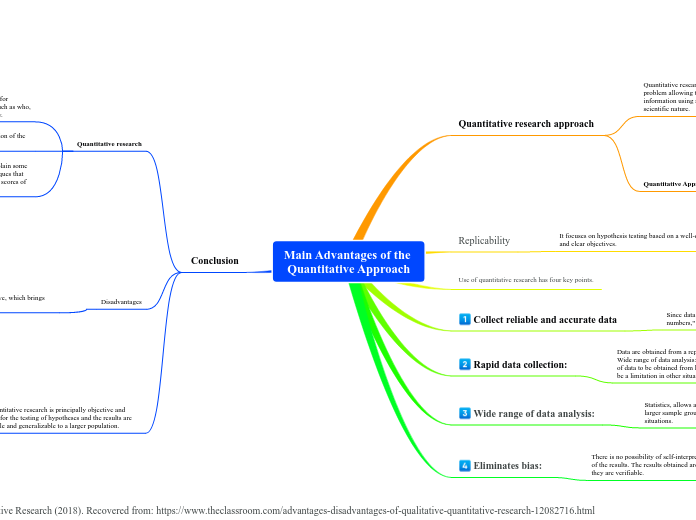Main Advantages of the Quantitative Approach
Quantitative research approach
Quantitative research approach is a research on a specific problem allowing to observe, count and analyze the required information using statistical techniques, being considered of a scientific nature.
Use of statistical data and analysis of research has advantages in being verified, confirmed and checked with greater precision.
Involves a research plan, allowing researchers to know how to interpret the results obtained to be more reliable, definitive and standardized.
Additionally, the quantitative approach helps researchers to optimize the time and effort invested in the analysis and description of the results obtained.
Quantitative Approach
Use of the quantitative approach simplifies the possibility of measuring how many and how often "situations" occur, it can be used to conduct research that includes a control group and two or more study groups to collect evidence that may be essential for statistical analysis.
Replicability
It focuses on hypothesis testing based on a well-defined plan and clear objectives.
Use of quantitative research has four key points.
Collect reliable and accurate data
Since data are "collected, analyzed, and presented in numbers," the results obtained will be truly reliable.
Rapid data collection:
Data are obtained from a representative group of a population.
Wide range of data analysis: Statistics, allows a larger amount of data to be obtained from larger sample groups, which can be a limitation in other situations.
Wide range of data analysis:
Statistics, allows a larger amount of data to be obtained from larger sample groups, which can be a limitation in other situations.
Eliminates bias:
There is no possibility of self-interpretation or preconceptions of the results. The results obtained are statistical. Therefore, they are verifiable.
Conclusion
Quantitative research
In conclusion, the quantitative approach is suitable for responding more precisely to the analysis of data such as who, how much, what, where, when, how many, and how.
Quantitative research is useful for doing segmentation of the sample group.
It is also useful to verify the data obtained or to explain some phenomena with the help of many statistical techniques that have been developed "for researchers to predict the scores of a factor or variable".
Disadvantages
The focus on numbers can also be restrictive, which brings with it some disadvantages.
The positivism paradigm does not find implications of the social phenomenon anywhere.
This approach fails to provide sufficient explanations of the reasons for the effect of certain variables or aspects on the study group within a detailed context.
A second limitation is that the positivism paradigm does not describe how reality is "configured" nor does it refer to how people "interpret" their behaviors.
Quantitative research may be insufficient if it focuses only on numbers, as there is a possibility that information that may be useful in drawing final conclusions may be lost.
When conducting quantitative research, some errors may occur if a hypothesis or method of data collection and analysis is not developed accurately, which may lead to invalidation of the results.
Finally, quantitative research is principally objective and appropriate for the testing of hypotheses and the results are valid, reliable and generalizable to a larger population.
